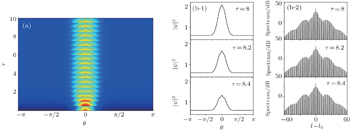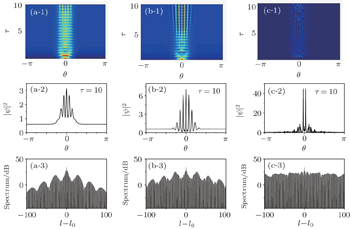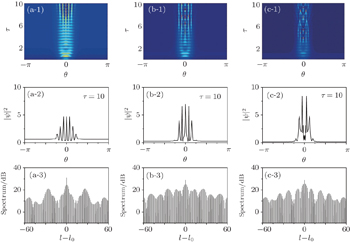† Corresponding author. E-mail:
‡ Corresponding author. E-mail:
Project supported by the National Major Scientific Instrumentation Development Program of China (Grant No. 2011YQ120022), CAS/SAFEA International Partnership Program for Creative Research Teams, China, and the National Natural Science Foundation of China (Grant No. 61275164).
We study the spatiotemporal evolution of the electromagnetic field inside a microresonator showing an anomalous dispersion at the pump wavelength by using the normalized Lugiato–Lefever equation. Unlike the traditional single continuous wave (CW) pumping, an additional pump source consisting of periodical pulse train with variable repetition rate is adopted. The influences of the microresonator properties and the pump parameters on the field evolution and the electromagnetic field profile are analyzed. The simulation results indicate that, in the anomalous dispersion regime, both increases of the input pulse amplitude and the repetition frequency can result in the field profiles consisting of multiple peaks. A series of equidistant pulses can also be obtained by increasing the CW pump power. In addition, we find that a large physical detuning between the pump laser carrier and the cavity resonance frequency also causes the splitting of the inside field.
The optical frequency combs are the indispensable tools for various applications, e.g., precision frequency metrology, absolute distance measurement, arbitrary waveform generation, accurate optical clocks, etc.[1–4] To date, in the practical applications, the realization of frequency combs is mainly founded on the mode-locked fiber lasers because of their robustness and reliable merits.[5–7] However, some drawbacks still exist for such kinds of frequency combs. For example, the mode spacing denoted by the repetition frequency of periodical pulse trains is restricted by the cavity length of the fiber laser. The largest mode spacing obtained to date is about several GHz.[8,9] Fortunately, the optical Kerr frequency combs generated from microresonator cavities with ultrahigh quality factors were reported a few years ago.[10–12] The mode spacing of the Kerr combs can be tens or hundreds of GHz,[13,14] even up to 1 THz,[15] which is much larger than that of the traditional frequency combs. Moreover, in addition to the large mode spacing, the Kerr combs also show the advantages of simplicity, small size, high degree of integration, and low power consumption.[16,17] Therefore, as the supplement for the traditional mode-locked laser-based frequency combs, the Kerr combs with high repetition frequencies are desirable for many applications, for example, calibration of astronomical spectrograph[18] and coherent terabit communications.[19]
Meanwhile, the generation of the optical Kerr frequency combs has also been studied theoretically. At first, the modal-expansion approach was employed to explain the generation mechanisms of the Kerr combs.[20,21] But it cannot be applied when numerous modes coexist in the microresonator.[22] In recent years, a modified model based on the well-known Lugiato–Lefever equation (LLE) is established. In this spatiotemporal Lugiato–Lefever formalism, the diffraction item is replaced by the azimuthal dependence of the intracavity field. With the aid of this formalism, the evolution of the laser field in a microresonator can be analyzed, even though there are a great number of modes interacting with each other in the cavity.[23] Furthermore, it was reported that the simulation results by using the LLE show good agreement with the experimental results.[24] To the best of our knowledge, the theoretical analysis of the Kerr combs based on the LLE is confined to the continuous wave (CW) pump cases. Moreover, the central wavelength of the pump source is selected to lie in the anomalous dispersion region of the microresonator. Compared with the normal dispersion region, in this case, a wideband Kerr frequency comb can be easily realized as shown by both experimental and theoretical studies.[25–27]
In this work, based on the normalized LLE, the spatiotemporal dynamics of the electromagnetic field in a microresonator with an anomalous dispersion is investigated. Unlike the traditional CW pumping case, the microresonator cavity is pumped by the combination of CW and periodical pulse train sources. The dependence of various electromagnetic field evolutions on the cavity detuning and the pump source parameters is carefully investigated. All these parameters are experimentally tunable. The calculation results show that both the increases in pump pulse amplitude and repetition frequency result in multiple peaks in the intensity profile. In addition, it is found that, in the anomalous dispersion regime, a series of equidistant pulses can be generated by raising the CW pump power. Chaos occurs with further increase of the pump power. Meanwhile, the analysis results show that large pump detuning is unfavorable for the generation of stable Kerr frequency combs.
The schematic diagram of the Kerr frequency comb generation system based on the combination of a tapered optical fiber and a microresonator is shown in Fig.
Referring to the existing work, the model describing a microresonator pumped by a CW laser is introduced as follows. It is supposed that the laser propagates along a straight track in the microresonator with periodic boundary conditions.[28,29] In this case, the variant of LLE named spatiotemporal Lugiato–Lefever formalism is found suitable for describing the evolution of the field inside the microresonator cavity.[30–32] The normalized LLE can be written as

For solving the LLE, the condition of ∂ ψ(τ, θ)/∂ τ = 0 is set and the corresponding steady-state solutions of the electromagnetic field in the cavity can be acquired by using the multi-dimensional Newton–Rhapson root-finding method.[24] However, the transient dynamics during comb formation are still unclear when this method is used. Therefore, instead, the split-step Fourier algorithm is utilized to discuss the evolution characteristics of the Kerr optical frequency combs.[33]
The field evolution in the microresonator pumped by a CW laser together with a periodic pulse source can be discussed by solving the LLE above. Here, a microresonator parameter named free spectral range (FSR) is introduced and it is defined as FSR = 1/tR, where tR is the roundtrip time of the laser inside the microresonator. The input periodical pulses are assumed to be produced by mode-locked lasers and the repetition frequency is denoted by f = FSR/m, where m is an arbitrary integer. Moreover, it is assumed that the center wavelength of the pump pulses is the same as that of the CW pump. Considering that the length of the tapered fiber is extremely short, the interaction between the pulses and the CW laser in the tapered fiber can be ignored. Thus, they propagate independently before entering into the microresonator cavity. In the interval between two consecutive input pulses, the field profile in the microresonator still follows the LLE. When the periodical pulses are imported into the microresonator, it is regarded that the input pulse field is added to the original field in the microresonator. Based on the above assumptions, the electromagnetic field produced by the synthetical pump is simulated by using the normalized LLE.
In this section, the evolution of the field inside the microresonator with anomalous dispersion is discussed. Bright solitons can form in the nonlinear optical cavity under the balance of nonlinearity and dispersion. This balance process mainly affects the soliton shape, and the amplitude of the soliton is determined by the balance between gain and dissipation. In particular, the initial pattern formation in the microresonator is caused by the modulation instability (MI) effect.[34,35] According to Ref. [34], the initial field envelope is set as a Gaussian function: ψ0 = 0.5 + 0.5exp[−(θ/0.5)2]. It has been reported that a soliton is generated when the cavity detuning 

We carefully study the effects of the pump pulse parameters on the field profile in the microresonator. In order to make comparison with the results shown in Fig.
In addition, the power of the external CW pump, which is proportional to F2, also plays an important role in the microcavity optical field evolution. The field evolution and the intensity profiles corresponding to different pump parameters F are displayed in Fig.
We further investigate the effect of the frequency detuning on the field evolution in the microresonator. The field evolution under different frequency detuning is displayed in Fig.
The spatiotemporal evolution of the electromagnetic field inside a microresonator with an anomalous dispersion is investigated. The cavity is pumped by the combination of CW and pulsed sources. Based on the normalized LLE and the split-step Fourier algorithm, the transient dynamics at different time during comb formation in the microresonator cavity are carefully studied. In the anomalous dispersion regime, both high amplitude and high repetition frequency of the pump pulse can result in multiple peaks in the field intensity profile. With the increase of the CW pump power, the field can evolve into a series of equidistant pulses and eventually into a chaos state. In addition, a large physical detuning can also result in the splitting of the input field and the occurrence of multiple peaks in the intensity profile. The theoretical analysis results obtained in this paper are crucial and helpful for the practical applications. According to the simulation results, the material of the microresonator and the pump parameters can be optimized for the Kerr frequency comb generation.
| 1 | |
| 2 | |
| 3 | |
| 4 | |
| 5 | |
| 6 | |
| 7 | |
| 8 | |
| 9 | |
| 10 | |
| 11 | |
| 12 | |
| 13 | |
| 14 | |
| 15 | |
| 16 | |
| 17 | |
| 18 | |
| 19 | |
| 20 | |
| 21 | |
| 22 | |
| 23 | |
| 24 | |
| 25 | |
| 26 | |
| 27 | |
| 28 | |
| 29 | |
| 30 | |
| 31 | |
| 32 | |
| 33 | |
| 34 | |
| 35 | |
| 36 | |
| 37 |








